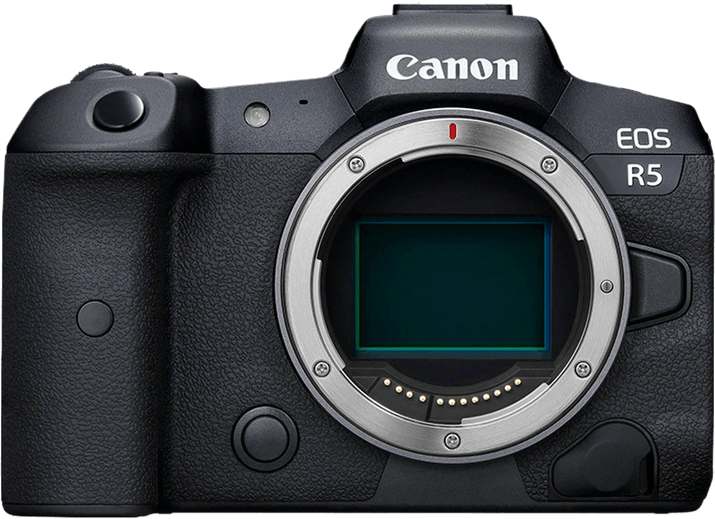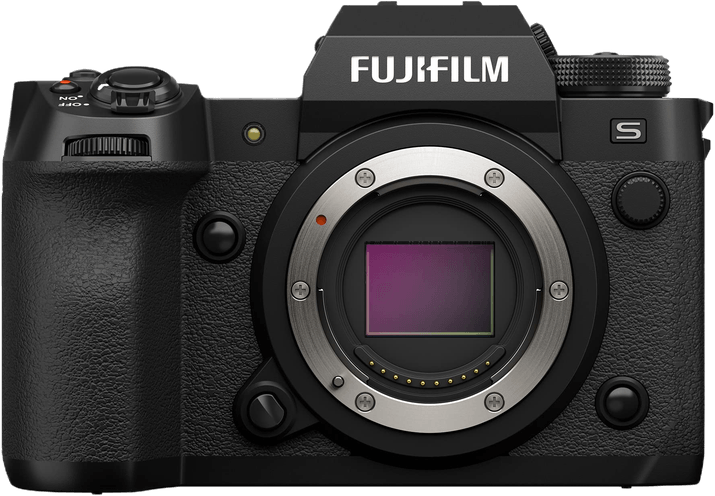Canon EOS R5 vs Fujifilm X-H2S Comparison
Canon EOS R5

Fujifilm X-H2S

The Canon EOS R5 outperforms the Fujifilm X-H2S with a score of 86/100 compared to 79/100. Both cameras are mirrorless and share similar dimensions and weight, with the R5 measuring 138 x 98 x 88mm and weighing 680g, while the X-H2S is 136 x 93 x 95mm and weighs 660g.
The R5 excels with its higher score, providing better overall performance. Released in 2020 at a launch price of $4499, the Canon EOS R5 offers top-notch features and quality, justifying its higher price.
On the other hand, the Fujifilm X-H2S, released in 2022 at a more affordable price of $2500, still offers solid performance despite its lower score. The X-H2S is slightly lighter, making it easier to carry during photography sessions.
Taking these points into account, the Canon EOS R5 is the better camera for those seeking superior performance, while the Fujifilm X-H2S is a more budget-friendly option that still delivers satisfactory results.
Canon EOS R5 vs Fujifilm X-H2S Overview and Optics
The Canon EOS R5 outperforms the Fujifilm X-H2S in optics with a score of 88/100 compared to 77/100. Both cameras share some common specifications, including a CMOS sensor, image stabilization, and a similar processor (Canon’s Digic X and Fujifilm’s X-Processor 5). The shared features provide a solid foundation for each camera’s optical capabilities.
The EOS R5’s superior performance is evident in its higher megapixel count (45 compared to 26) and full-frame sensor size, compared to the X-H2S’s smaller APS-C sensor. These factors contribute to the R5’s higher DXOMARK score of 95. Additionally, the Canon RF lens mount offers a broader range of lenses, providing more options for photographers to enhance their image quality.
On the other hand, the Fujifilm X-H2S showcases a faster shooting speed of 40 frames per second, twice that of the EOS R5’s 20 frames per second. This advantage allows the X-H2S to capture fast-moving subjects more effectively. However, this advantage may not compensate for the lower megapixel count and smaller sensor size, which can affect image quality and resolution.
In terms of optics, the Canon EOS R5 is a clear winner due to its higher megapixel count, larger sensor size, and broader lens compatibility. These factors contribute to its superior image quality, making it an excellent choice for photographers prioritizing high-resolution images. While the Fujifilm X-H2S offers an impressive shooting speed, its overall optical performance falls short compared to the EOS R5.
Canon EOS R5 vs Fujifilm X-H2S Video Performance
The Canon EOS R5 outperforms the Fujifilm X-H2S in video capabilities with a video score of 100/100, while the Fujifilm X-H2S achieves a score of 83/100. Both cameras share common features, such as built-in time-lapse functionality, which is useful for creating dynamic and creative video content.
The Canon EOS R5 surpasses the Fujifilm X-H2S in multiple aspects. It boasts a maximum video resolution of 8K (8192 x 4320) compared to the X-H2S’s 4K (4096 x 2160) resolution, providing four times the detail and sharpness. Additionally, the R5 offers a maximum video frame rate of 120fps, enabling users to capture smooth slow-motion footage. This is double the frame rate of the X-H2S, which has a maximum of 60fps.
The Fujifilm X-H2S, on the other hand, still has commendable video capabilities. Although it does not match the R5 in terms of resolution and frame rate, it provides a solid 4K video quality suitable for most videography needs. Its 60fps frame rate is sufficient for capturing smooth motion and some slow-motion effects.
Considering these points, the Canon EOS R5 is the superior choice for those seeking advanced video features and the highest possible quality. Its 8K resolution and 120fps frame rate make it a powerful tool for professional videographers. The Fujifilm X-H2S, while not as advanced in video capabilities, remains a reliable option for those with less demanding requirements and a preference for 4K video quality.
Canon EOS R5 vs Fujifilm X-H2S Features and Benefits
The Canon EOS R5 triumphs over the Fujifilm X-H2S in features with a score of 87/100, a difference of 17 points from the Fujifilm X-H2S, which scored 85/100. Both cameras share several specifications, such as touchscreen capabilities, flip screens, WiFi, Bluetooth, and the absence of GPS.
The winning camera, Canon EOS R5, excels with its larger screen size of 3.2 inches compared to the Fujifilm X-H2S’s 3-inch screen. Additionally, the EOS R5 boasts a higher screen resolution of 2,100,000 dots, providing users with a sharper and clearer display than the X-H2S’s 1,620,000 dots. These advantages contribute to the Canon EOS R5’s higher feature score, showcasing its superiority in terms of screen size and resolution.
Though the Fujifilm X-H2S falls short in comparison to the EOS R5, it still maintains a high feature score. The X-H2S matches the EOS R5 in terms of touchscreen, flip screen, WiFi, Bluetooth, and lack of GPS, demonstrating that it is a competent camera despite its lower score.
Taking these points into account, the Canon EOS R5 emerges as the better camera in terms of features, thanks to its larger screen and higher resolution. However, the Fujifilm X-H2S still offers a competitive set of features, making it a viable option for users who prioritize other aspects of a camera. Ultimately, the choice between these two cameras depends on individual preferences and priorities.
Canon EOS R5 vs Fujifilm X-H2S Storage and Battery
The Fujifilm X-H2S wins in storage and battery with a score of 76/100, while the Canon EOS R5 scores 68/100. Both cameras feature two memory card slots and USB charging capabilities. The X-H2S accepts CFexpress Type B and SD (UHS-II compatible) cards, while the EOS R5 supports SD/SDHC/SDXC (UHS-II compatible) and CFexpress cards.
The X-H2S outperforms the EOS R5 in battery life, offering 580 shots compared to the R5’s 320 shots. The X-H2S uses the NP-W235 battery type, whereas the R5 uses the LP-E6NH battery. This longer battery life makes the X-H2S more suitable for extended shooting sessions.
The EOS R5, however, has the advantage of accepting a wider range of memory card types. This flexibility can be beneficial for users who already own various memory cards or prefer specific brands. Despite this advantage, the X-H2S still scores higher due to its superior battery life.
Considering the storage and battery aspects, the Fujifilm X-H2S is the better choice for those who prioritize longer battery life, while the Canon EOS R5 provides more flexibility in memory card options.
Canon EOS R5 vs Fujifilm X-H2S – Our Verdict
Are you still undecided about which camera is right for you? Have a look at these popular comparisons that feature the Canon EOS R5 or the Fujifilm X-H2S:

